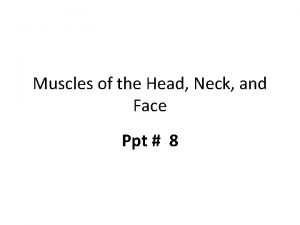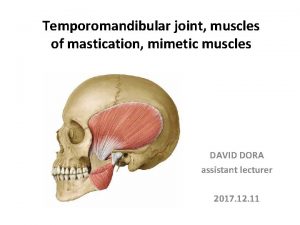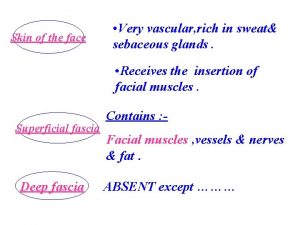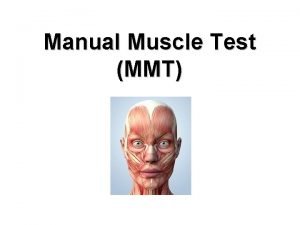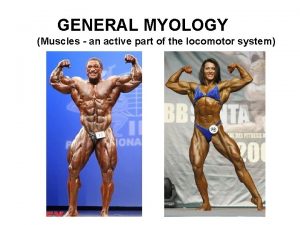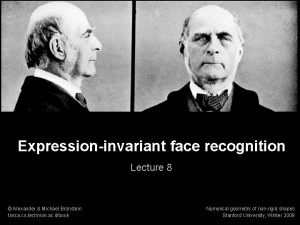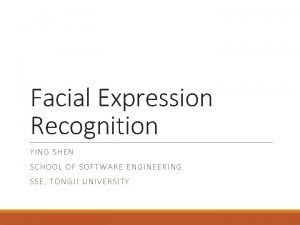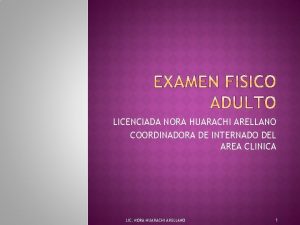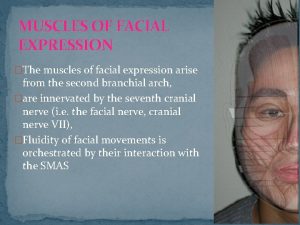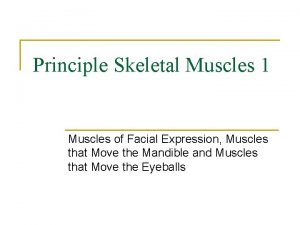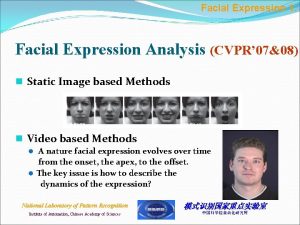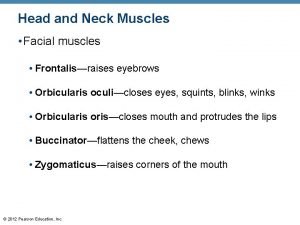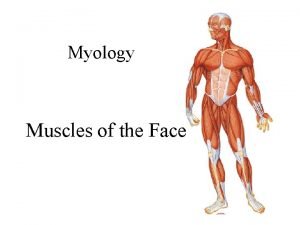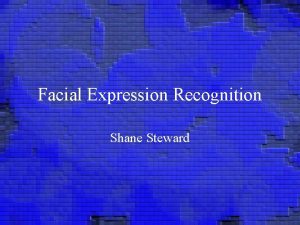Muscles of Facial Expression in Otolemur With a











- Slides: 11

Muscles of Facial Expression in Otolemur, With a Comparison to Lemuroidea presented by: Amy Christine Burrows, Anne M. , and Timothy D. Smith. 2003. Muscles of Facial Expression in Otolemur, With a Comparison to Lemuroidea. Anatomical Record 274 A: 827 -836.

Background Facial expression has become highly derived and differentiated in mammals relative to more primitive vertebrates. l The basic developmental portions of this musculature are the undifferentiated platysma and sphincter colli profundus sheets. l Muscles of facial expression are involved in various activities, such as mastification, vision, and respiration, but their major role is nonverbal communication, such as close proximity social signing. l

Background l In primates, binocular vision, increased visual activity, and convergence are so well developed that close-range visual cues, such as facial expressions, take on special importance in social interactions.

Background As the phylogenetic scale progresses from prosimians to humans, complexity of facial musculature and corresponding actions increase. l Form and function of the facial musculature have been well described in catarrhines, but they are relatively poorly understood in prosimians. l In earlier studies of Otolemur, only seven muscles were reported on the facial musculature: occipitofrontalis m. , atollens aurem m. , attrahens aurem m. , retrahens aurem m. , orbicularis palpebrum m. , orbicularis orism. , and the “nasal region” mm. l

Background l Prosimian muscles of facial expression were examined in the greater bushbabies, O. crassicaudatus (largeeared bushbaby) and O. garnettii (small-eared bushbaby). Family: Galagonidae l Nocturnal and like forests/woodlands. l

Materials and Methods l l 10 preserved heads from O. crassicaudatus and 8 from O. garnettii were obtained from Duke University Medical Center. Brains and calvariae had been removed in previous experiments. A midline incision was made over the nasal and oral regions down into the neck to separate the left and right portions of the face. As much superficial facial musculature was removed as possible to leave none behind, creating a facemask.

Materials and Methods Face masks were allowed to dry for 30 -60 min in order to remove remaining fascia and other connective tissue. l Text and diagrams from earlier studies (Ruge 1885 and Murie & Mivart 1872) were used to help identify muscles. l

Results Appearance of facial muscles in the O. garnettii. l Yellow are superficial, pink are deeper. l Retrahens aurem m. is not shown here b/c the calvariae was removed & it was not possible to evaluate the attachements. l

Results & Discussion 17 muscles in Otolemur were found as opposed to 7 in the previous study, indicating that Otolemur facial expression is far more complex than previously described. l The number and arrangement of muscles found closely resembles the condition of Lemur. l It is apparent that Otolemur cannot be regarded as having a more primitive arrangement than any of the members of the Lemuroidea. l

Results & Discussion Few differences between the two tested types of bushbabies were noted. Except O. garnetti appears to have a more robust, distinct musculature associated with the ear and oronasal regions. l These muscles include: orbitoauricularis, nasalis, and sphincter colli muscles. Which move the ear complex, nares, mysticial vibrissae, and the skin around it. l This may be due to the higher degree of territorial displays in the O. garnettii, a difference in diet, and also localizing prey. l

Phylogenetic Aspects There is a reduction of the attachment of the occipitofrontalis/ attrahens aurem/ attollens aurem grouping to the ear in lemuroids compared to Otolemur. l Previous authors have described complex movement of the external ear in Otolemur social interactions, while similar descriptions for lemuroids are lacking (where expressions of the mouth are more common). l Considering the far greater number of muscles found in Otolemur, and their similar arrangement relative to lemuroids, these results may be useful for ongoing research into taxonomic relationships b/w the lorisoids and lemuroids, and the position of Otolemur relative to other Galaginae. l
